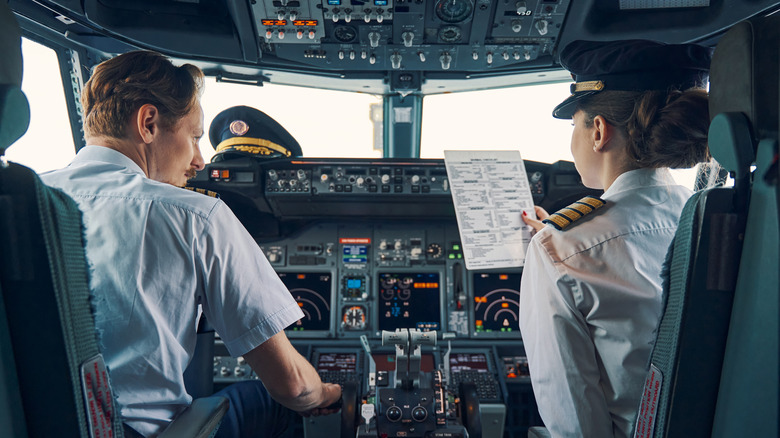Pilots Sleep In A Part Of The Plane You've Likely Never Even Seen
When you take a long flight, chances are you contemplate how to make sleeping on the plane easier. After all, you wouldn't want to arrive at your destination feeling drained and jet-lagged. But besides your own in-flight shut-eye, have you ever given thought to how pilots sleep on planes? Pilots need to sleep in the air, just like the rest of us, particularly on long-haul journeys. However, they don't just nap in the cockpit. They have a special sleeping compartment, according to Captain Richard Levy, a retired captain who spent 41 years working with a major international airline and currently serves as a flight crew training instructor and aviation expert for attorneys. And — as you might've guessed — the crew sleeping space is much more comfortable than what you get in the economy cabin.
The former pilot shared exclusively with Explore that most wide-body, long-haul passenger aircraft contain a "crew rest compartment" above the main cabin. Think of it as a hidden bedroom, similar in size to a capsule hotel room. Inside, there are at least two beds and, if space allows, a chair for lounging. Captain Levy explains that there are specific requirements for the compartments set by regulators. For instance, the spaces should block disruptive noise and odors that could impact the pilots' sleep quality. They should also be kept at a comfortable temperature and come with adjustable lighting.
How long are pilots allowed to sleep?
Getting quality rest on long flights can feel like winning the lottery. But for flight crew, it's imperative. With that said, pilots aren't generally allowed to clock a full eight hours of snoozing time during a typical flight. Instead, the crew members are limited to shorter rest breaks. "When I flew wide-body aircraft on nonstop long-haul flights, I would divide the flight time by four," Captain Richard Levy says. "This would allow for four crew rest breaks of equal time." On a flight lasting 17 hours, this would equate to roughly a four-hour break for each pilot, where they can relax or sleep in the crew rest compartment.
Some other airlines prefer to divide the flight deck crew into two groups, with one manning the plane during the first half of the flight and the other taking over in the second half. On long routes, this gives each pilot more time to recharge and maintain a somewhat regular sleeping schedule. The veteran captain adds, "Either method works and accomplishes the primary goal: fully-rested pilots able to safely fly the aircraft and make the correct decisions at the right time to keep the highest priority in the forefront — safety of the passengers and safety of the crew." If you have doubts about a pilot's sleep quantity, keep in mind that they also have a chance to catch some Zs while on the ground. In fact, pilots are required to survive a long layover in each destination before attending their next flight, according to Captain Levy.
The plane is never without pilots manning the cockpit
No matter your flight route or length, you never have to worry that all the pilots on board are snoozing away while the plane cruises at 30,000 feet. Someone is always there overseeing the cockpit, from the time the plane takes off until it safely reaches the airport. However, the number of required pilots can vary, says Captain Richard Levy. The retired captain tells Explore that only two pilots are required on board for flights lasting eight hours or less. "That would normally be a captain and a first officer," he notes. In these instances, sleep breaks aren't built into the schedule. For flights lasting longer than eight hours, three or four pilots are on deck, allowing for alternating break times.
While one or two pilots may step away at a time to rest during long flights, the entire crew is required to be in the cockpit during takeoff and landing. This is necessary for safety reasons, as well as to manage flight changes caused by weather. Captain Levy shares that he once had to divert a flight bound for Hong Kong due to a typhoon, which, as the captain, meant he needed to be available during the final four hours of the flight. In similar cases, pilots may rearrange their sleep breaks to ensure they're awake at critical times.


